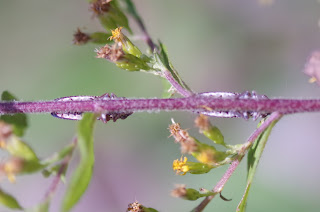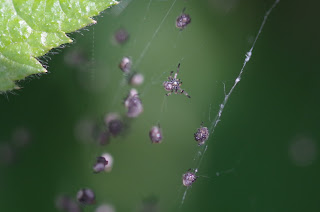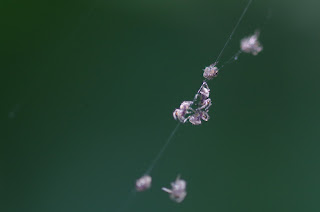One reason to travel is because you are able to see things in person that previously you might have only read about or seen in pictures, or on a screen; Niagara Falls, the Pacific Ocean, the Great Wall of China (I have traveled to see two of those three things, and it was not the Great Wall of China). But sometimes you don't even have to travel to see the things you've only read about, like the times I walked out my back door to see the Aurora Borealis. That is something that is absolutely worth traveling to see, I just got lucky and was able to experience that breathtaking phenomenon at home in my own backyard.
Ever since I started to get interested in the insect life around me I have experienced more of that type of incident, in which I read about something, and then I see it in real life, in my backyard. Like watching a caterpillar become a chrysalis (though that I have actually seen in my dining room, not my backyard), or watching a butterfly eclose (also seen in my dining room). Or seeing a praying mantis eat a caterpillar, or a spider build a web, or wrap an insect it has caught in silk threads.
Today I sort of witnessed something that before now I have only read about, albeit indirectly. You may recall, if you've been reading this blog for the last month or so, that one of the monarch caterpillars that I adopted failed to turn into a chrysalis. It began the process, hanging upside down for a day or so, and then actually started the transformation, beginning to shed its skin, but that is where it stopped. The skin split, and a bit of the chrysalis-to-be poked out, and then it stopped. I waited for a while, and then figured the transformation was not going to happen. I felt like I had failed this caterpillar, and worried that I had not taken good enough care of it, that it had succumbed to some caterpillar disease because of me. But really, I wasn't sure there was anything that I could have done, in part because that particular caterpillar was only a couple of days from chrysalizing when I adopted it; it was pretty big when I found it. It spent most of its life outside, where it was certainly vulnerable to a variety of caterpillar afflictions. So when it became clear that it was never going to become a chrysalis, or a butterfly, I removed it from the caterpillar enclosure, not knowing if it had some kind of disease that could infect the other caterpillars. Since then no other has failed to chrysalize or shown any sign of disease. I didn't just throw out the afflicted caterpillar, though. I put it inside my bug viewer, a small, plastic, container with tiny air holes that is meant as a child's toy for examining insects. It works as a grown-up, too, though I don't use it much, because I don't really need it. Still, I put the poor caterpillar in it, just to see what would happen to it, though I don't know what I was expecting. What happened is that it turned black, and slightly shriveled. I don't know why I have left it there for all this time, or why I check on it once in a while... well, actually, I do know. I have done some reading about caterpillar diseases, and the many things that keep them from becoming butterflies or moths, so I was aware of the possibility that the caterpillar was infected by a parasite, and thought maybe that something would emerge from the shriveled remains.
And that is exactly what has happened. I looked at the bug viewer today and there was a fly in there. Just this week I read about Tachinid flies, a family of flies that are parasitoids of other insects, mostly caterpillars. Parasitoids are different from parasites in that they kill their host. I had not seen any parasite eggs on the caterpillar (though I have often see caterpillars that were infested with parasite eggs, in fact, a lot of them this summer. I always feel bad for those caterpillars), but some parasitoids inject their eggs into their prey, or lay eggs on leaves which are then eaten by caterpillars, so from the outside you can't tell that they are infected. Most of what I read (In Kaufman's Field Guide to Insects of North America, along with other places I can't remember) was pretty gruesome, and I don't have the stomach to repeat it. But it was kind of an amazing moment to realize that I was witnessing one of those things that before I had only read about. Nature in action on my dining room table:
The fly inside the bug viewer. I guess I have to release it outside. A part of me hates the idea of releasing it to prey on more caterpillars, but I don't usually like to take sides on what nature does; yes, I am protecting monarch caterpillars, but maybe this one will go out and prey on the caterpillars that are destroying the Brussels sprouts in the garden. And there are already a LOT of Tachinid flies out in the backyard.
Backyard Bug of the Day:
Leaf hopper
An unusual find:
I have frequently seen insects and spiders that are missing limbs, and have seen grasshoppers missing legs, but I have never seen one missing both of its back legs.
It can still walk, but not jump. And you can see that it is a nymph, with wings that are not fully developed, so it can't fly yet. I guess it is somewhat limited in its mobility for now. I have read that grasshoppers can regenerate missing limbs as long as it happens before they reach their adult stage, that they will get new ones when the molt, but I have also read that that is not true. It does seem kind of unlikely looking at this.
Nearby, another grasshopper, different species, adult.
Other Bugs:
I think this is a garden caterpillar, about the most generic name possible, and not terribly descriptive, given the number of different caterpillars one might find in a garden.
Sharpshooters. One of the most camera-shy insects in the backyard.
Even predators can become prey: assassin bug feeding on a ladybeetle
I think this is a thick-headed fly
Looper caterpillar doing an fairly convincing stick impression.
Bumblebees on autumn joy sedum. This is the first year that these flowers have really attracted any bees. In past years I have been puzzled by the lack of pollinator activity on these flowers, but this year they are suddenly popular.
The caterpillar never does anything, but the leaf is showing some action: it is beginning to curl up. I wonder if the caterpillar will react to it at some point, or just keep sitting there as the leaf curls around it. I do think the caterpillar's color is appearing darker; maybe it's getting a tan from all that lounging in the sun.
I took a closer look at the spicebush swallowtail butterfly egg today:
It appears to have silk threads of some kind tying it down, which I think must be from the caterpillar currently curled up in the leaf.
Magnified it looks like there are things developing inside?
Arachnid Appreciation:
.
.
.
.
.
.
.
.
.
.
.
.
Spiderlings!
This is the exact same spider that I encountered a few days ago. It is still belligerent:
At this point it is standing up on its back legs, waving its front legs at me. I have never seen a flower crab spider behave this way. I have sometimes seen jumping spiders look kind of defiant (and jump on me), or other spiders raise their front legs in a defensive posture, but flower crab spiders have always just receded and hidden when they think I have gotten too close. I have never seen one act so combative. It's kind of cute, really.
On the screen door when we got home this evening.





























No comments:
Post a Comment